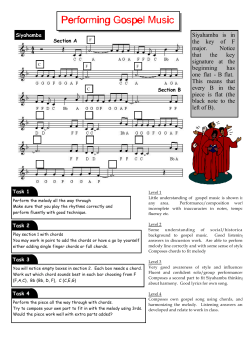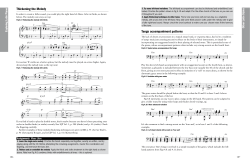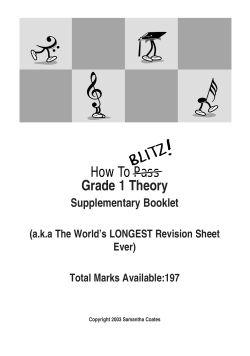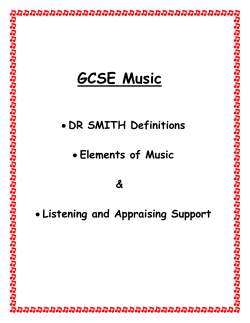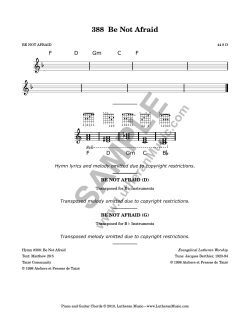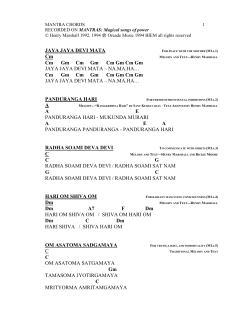
Revision Notes
Y10 Listening Paper Revision Notes Key Points: In the listening paper you will listen to various styles of music and be required to describe them using the correct musical terminology Most questions are either multiple choice or require one word answers, some questions will require you to write in full sentences in detail – these are often worth 4 marks There will be questions that require you to write in a melody or rhythm The paper is for 1hr in total and is worth 20% of your final grade Required Terminology Dynamics (How loud or Soft) You will need to know the following signs and practice recognizing dynamic contrasts in a piece of music P (piano) = soft, PP (pianissimo) = very soft, MP (mezzo piano) = moderately soft F (forte) = Loud, FF )fortissimo) – Very loud, MF (mezzo forte) = moderately loud Crescendo = Gradually louder Diminuendo – Gradually softer Sf (sforzando) = suddenly loud Practice listening to pieces by Mozart or Tchaikovsky using the words above to describe the changes that take place. Pop pieces are not suitable to practice for this area. Tonality (The Key the music is played in) You will need to be able to say what key the music is in: Major (will sound happy/positive) Minor (will sound dark/depressive) Modal (is a mixture of major and minor – it may have a medieval feel to it) Often pieces change key as the piece develops, particularly from one section to the next, so practice recognizing this. You also need to be able to identify the key from the key signature on the stave up to four sharps or flats in a major or minor key. We will practice this in lesson time, but you can also use musictheory.net to help Rhythm and Metre (a collection of different beats and the time signature) Dotted Rhythms, Syncopation (an offbeat rhythm), Triplets (three notes played on one beat) Drum fills (this where a drummer plays a ‘fill’ pattern using the toms and cymbals) Polyrhythm (two or more different rhythms played at the same time) Bi Rhythm ( a feeling of three against two – common in African music) Regular, Irregular (An irregular rhythm is where the rhythm changes all the time and it feels very disjointed, a regular rhythm is one where there is a consistent and repetitive idea) Simple or Compound time signatures (you will need to practice recognizing the difference between the two) Tempo (be ready to describe how fast a piece is played and how this might change) Rubato (where the performer varies the pulse to make it much more expressive) Hemiola (a rhythm feature) Cross rhythm (a type of polyrhythm, this is where one rhythm pattern is contradicted by another rhythm pattern which has accents in different places – the effect is that it becomes hard to recognize the time signature) Melody (The Tune) These words are used to describe the melody – beware, you do not use these words to describe other layers! Intervals! (This is the relationship between one note and the next – common intervals are a 3rd, ding dong, 4th A-way in a manger, 5th Twinkle, Twinkle or an Octave, Somewhere over the rainbow) Conjunct or Disjunct (Conjunct is when the melody mainly moves in step, Disjunct is where the melody has lots of wide leaps and moves around erratically) Broken chords, Arpeggio (These features are often found in the bass part, but you sometimes find melodies that have a broken chord feel) Scalic (Melodies in the classical period often have a scalic feel, Indian pieces begin with a scale – basically any melody that sounds like a scale) Diatonic (this is a melody that belongs to a major or minor key) Chromatic (this is a melody that is based around the chromatic scale – moves around in semitones) Pentatonic (a five note scale, these melodies are used in folk music and some types of world music a lot) Sequence (a short melody that is repeated up or down in pitch – usually up or down a step- common in classical music) Slide/Glissando/Portamento (this is common in vocal music) Ostinato (this is a short repeated pattern, often in the bass), Riff (a short repeated pattern, this word is often used to describe what the guitar is playing Phrasing (melodies are usually phrased in a two or four bar structure) Pitch bend (as it sounds – guitars or similar are good at these) Improvisation (made up! Indian music and some vocal music has an improvised feel) Articulation (the way a note is played) – Legato (smooth), Staccato (detached), Accent (a note is emphaised) Ornaments (decorations added to some notes, the most common are trills, but you also get acciaccaturas which are a single quick note played before the main note – found in classical music) Augmentation (this is where the notes of the melody are extended) Diminuention (the opposite) Blues Notes (In blues music, some notes of the scale are flattened to give the music a jazzy feel) Inversion (this is where the melody is effectively played upside down – same intervals, but the opposite way) Modal (a type of scale in the medieval period, but used by some Jazz and Rock musicians) Whole Tone (a five note scale) Texture (the layers) Homophonic (the most common – one melody with an accompaniment – piano and chords, voice and guitar etc..) Monophonic (one melody, no chords, no other instruments – a flute playing a tune) Polyphonic (two or more melodies played together at the same time – common in the Baroque period) Unison (all the instruments playing the same melody) Imitation (one instrument copies another) Canon (One melody is copied by another instrument but the other instrument will start two bars later – also known as a round) Harmony (two or more notes played together at the same time) Diatonic (where chords belong to a major or minor scale) Chromatic (a chord that does not belong to the key signature, for instance a Bb chord is played in a C major piece, this would be chromatic because Bb is not in the key of C major) Dissonant (this is where two or more notes create a clashing sound) Consonant (this is where the notes sound pleasing – any major or minor chord effectively) Cadences! (There are four types: Perfect – at the end of a piece, sounds complete, Imperfect – sounds incomplete, like the piece wants to carry on, Interrupted – sounds like the piece wants to carry on, Plagal, a-men feel. Structure and Form (the way a piece of arranged) Binary (A:B) – sometimes called Minuet and Trio Ternary (A:B:A) – in Opera, this is called a Da Capo Aria (aria means song) Rondo (A:B:A:C:A) Ground Bass (a piece based upon a recurring 8 bar bass pattern that does not change) Theme and Variation (where you are presented with a simple melody and you then hear a range of variations on that theme) Sonata (a solo piece, often for piano or any other orchestral instrument) Continuo (a chord backing to a Baroque piece, played by a Harpsichord) Popular song structures – verse/chorus etc… Suggested Listening List Lennon/McCartney ‘She loves You’ Beatles Jagger/Richards ‘I Can’t get no Satisfaction’ Rolling Stones Baroque Orchestral Music Bennett/Welch ‘Summer Holiday’ Cliff Richard Vivaldi ‘Spring’ from “The Four Seasons” Rock Music, R’n’ B, Hip-Hop Bach Brandenburg Concerto No. 2 in F BWV 1047 Page/Plant ‘Stairway to Heaven’ Led Zeppelin Handel Water Music West ‘Gold Digger’ Kanye West The Concerto Ne-Yo ‘Take A Bow’ Rihanna Haydn Trumpet Concerto in E flat Music Theatre Tchaikovsky Violin Concerto No. 1in D Op. 35 Schwartz ‘Defying Gravity’ Wicked Shostakovich Piano Concerto No. 2 in F Op. 102 Bart ‘I’m reviewing the Situation’ Oliver Music for Voices Lloyd-Webber ‘Any Dream Will Do’ Joseph and the Gibbons ‘The Silver Swan’ Amazing Technicolor Dreamcoat Puccini ‘Nessun Dorma’ from “Turandot” Film Music Orff Carmina Burana Williams “Star Wars” Chamber Music Marianelli “Atonement” Haydn String Quartet in C Op. 76 No. 3 ‘Emperor’ Zimmer “Gladiator” Schubert Piano Quintet Op. 114 D 667 ‘The Trout’ Stravinsky 8 Miniatures for 15 Players The Sonata Scarlatti Piano Sonata in Gminor ‘Cat’s Fugue’ Beethoven Violin Sonata No.5 in F Op. 24 ‘Spring’ Chopin Piano Sonata No. 2 in B flat minor Op. 35 Blues Johnson ‘Come on in my kitchen’ Robert Johnson King/Josea ‘You upset me Baby’ BB King Clapton ‘Sunshine of your Love’ Cream Popular Music of the 1960s Use Youtube to listen to music from Africa, The Caribbean and India Listening Diary Name of Piece and Composer Type of Piece (sonata, chamber music) Tempo Structure Brief description of the dynamics for the first 30 seconds What contrasts are used between sections? (practice writing in detail here, in section B, the rhythm is now swung) Any other valuable observations
© Copyright 2025

